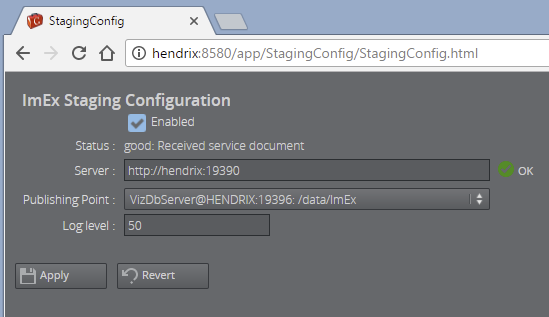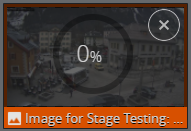
Viz Multiplay User Guide
Version 3.1 | Published July 20, 2023 ©
Using Graphic Hub Image Staging
This section covers how to use the Viz GH ImEx Agent, a Graphic Hub staging mechanism that automatically transfers images from URL resources to Graphic Hub.
The agent downloads and prepares the URL resources with the suitable compression level before transferring them to Graphic Hub. This means they use minimal resources on the renderer when taken to air, playing out without any framedrop.
These are the following topics:
Required Components
The workflow requires:
-
Viz Graphic Hub
-
Viz Graphic Hub REST service
-
Media Sequencer version 5.0 or higher
Configuration and Setup
Install and configure Graphic Hub ImEx over three steps by installing the ImEx Agent, creating an image staging folder and setting a publishing point.
Info: This procedure requires the following components to be installed: Media Sequencer 5.0 or higher, Graphic Hub and the Viz Graphic Hub REST service.
Install
Install the Viz GH ImEx Agent.
Create Image Staging Folder
Create a folder in Graphic Hub where images should be staged to. See the Servers and Folders section in the Graphic Hub Administrator Guide on how to create a folder.
Set Publishing Point
Use the Viz GH ImEx Agent to set up a publishing point to the folder through the GH REST service.
-
Enter the URL to the Viz GH ImEx Agent, then click Options and GH REST Hosts.

-
Click Add GH REST Host.
-
Select a server or enter the service document from a GH REST AGENT manually.
Workflow in Viz Multiplay
Enable media transfers via the ImEx Agent using the Viz Multiplay interface.
-
Click Settings > General, then click the GH ImEx staging config button.
-
The configuration application opens in a new tab in the browser:

Info: The Server field contains the URL to the Viz GH ImEx Agent. This service is usually found on port 19390 on the host where it is installed.
Note: If Media Sequencer is configured with HTTPS, the ImEx Staging application will be opened through the HTTPS protocol. The ImEx Staging Configuration application does not support HTTPS, which means that the HTTP address of the config app must be manually used in the browser: http://mse-host:8580/app/stagingconfig/stagingconfig.html.
-
If the connection is good, the Publishing Point dropdown is populated with possible Graphic Hub backends, where the images will be transferred.
-
After activating a show profile, Media Sequencer monitors images in the show and transfers from the URL source to the publishing point.
-
During the publishing operation, the progress is shown on the image, as shown here:

When the image is ready, the progress disappears:

Info: Set the Log level to a value between 0 and 100 to adjust the amount of log messages from the Image Staging handler on Media Sequencer. A higher level generates more log messages. This can be useful when inspecting the system during debugging. The log messages appear in the Media Sequencer log.
The Revert button undoes any local changes in the config window. It does not reset anything on Media Sequencer.
The Apply button applies the current settings to Media Sequencer.